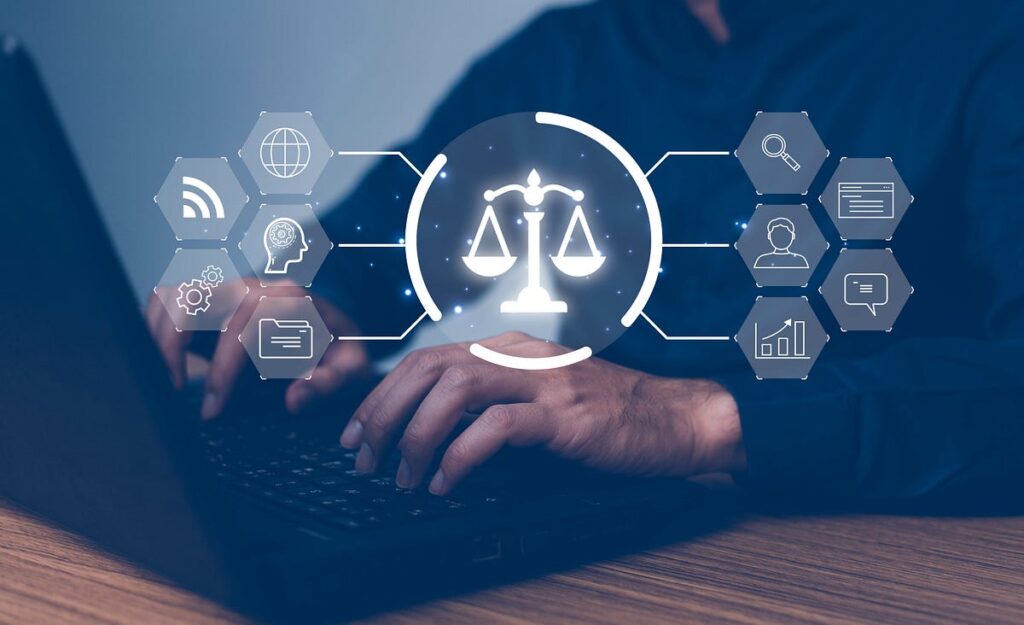AI and law have created a partnership that changes the legal profession faster than ever before. The International Monetary Fund reports AI could affect 40% of all jobs worldwide, which brings major changes to legal professionals. AI technology shows promise to save lawyers 200 hours of work time each year.
These numbers might raise eyebrows, but lawyers won’t be replaced – they’ll need to adapt. Law firms have embraced AI as a powerful ally, and 56% of major firms believe AI will become standard practice within five years. The path forward brings challenges like AI hallucinations and complex jurisdiction issues.
Let’s dive into AI’s role in transforming legal practice and share strategies you can use today. You’ll discover success stories from firms of every size and learn what it takes to thrive as the legal world evolves quickly.
Current AI Tools Reshaping Legal Practice
AI tools are changing the legal technology world by solving real-life problems for attorneys of all specialties. Law firms nationwide already see practical results from these solutions, not just theoretical possibilities.
Document review and contract analysis systems
AI-powered contract review systems can analyze thousands of documents simultaneously and deliver results in seconds instead of hours. Legal teams typically spend more than two hours reviewing a single contract (52% of respondents in a 2025 survey). These tools boost efficiency by up to 85% while maintaining compliance standards. Modern systems can spot key clauses like confidentiality agreements and termination conditions. They automatically flag risky terms and verify regulatory compliance. This lets attorneys focus on strategic work.
Legal research platforms with AI capabilities
AI assistants paired with authoritative content have altered the map of legal research. Lexis+ AI’s Protégé helps attorneys do research through natural conversation. Westlaw Edge uses AI to speed up complex legal research with predictive suggestions. Bloomberg Law has spent over a decade refining its AI capabilities. Their systems search the largest collections of case law and secondary sources to find accurate results quickly. Attorneys now need much less time to find relevant precedents and legal authority.
AI-powered drafting assistants
AI has improved drafting efficiency in remarkable ways. It generates first drafts for full transactional documents, litigation motions and complaints. Attorneys can now go from blank page to first draft quickly—customized to specific jurisdictions and preferred styles. It also spots missing clauses, inconsistencies, and contradictions in contracts. This ensures better document preparation. The most advanced solutions can draft detailed deposition questions and discovery documents based on case materials.
Client intake and case management solutions
AI has optimized client acquisition and management through automated intake forms and intelligent chatbots. This automation helps solve a big problem – nearly 64% of firms don’t deal very well with responding to clients within 24 hours. Case management platforms like SmartAdvocate come with built-in AI tools that quickly summarize cases, medical records, and depositions. MyCase IQ can suggest relevant tasks or events based on client communications. Some systems can evaluate case merits to help firms prioritize matters.
Step-by-Step Guide to Implementing AI in Your Law Firm
Law firms must tailor their approach to implement artificial intelligence and legal technology based on their unique needs. Research shows that 79% of law firms expect AI to revolutionize their operations in the next five years. Your firm needs a step-by-step plan to make this transition work.
Assessing your firm's specific needs
Your first step should be a complete evaluation of your practice areas and workflow challenges. Legal practitioners now use AI tools in at least seven areas: legal research, document automation, predictive analysis, legal review, case management, client communication, and marketing. These tools should line up with your firm’s challenges. While over 75% of attorneys see AI as a way to boost productivity and efficiency, only 25% actually use it. This shows a major gap in adoption.
Evaluating available AI solutions
The selection of AI tools must prioritize strong security protocols. Lawyers cannot input confidential client information into systems without proper protection. You should work with IT professionals to verify that any system meets strict security standards. On top of that, you need to check vendor credentials. The best legal AI solutions come from developers who work with legal experts and use high-quality data.
Creating an implementation timeline
A step-by-step approach works better than trying to change everything at once. Start with a small pilot project that focuses on one manageable use case. This lets you test and refine before rolling out more widely. Firms that showcase early wins build more confidence for broader adoption.
Training staff and measuring results
Training makes all the difference – every non-partner shows interest in ethical AI applications, and over 90% want practical training. Create programs that cover technical features, ethical guidelines, and workflow changes. Set clear rules about acceptable AI uses and oversight measures. After you start using AI, keep track of time saved and accuracy rates to show your return on investment.
Real-World Success Stories: How Lawyers Are Using AI Today
Law firms now see real results from adding AI to their practice. Their real-life experiences show that AI brings measurable benefits today, not just theoretical possibilities.
Solo practitioners using AI to compete with larger firms
AI helps small law practices compete with their well-funded rivals. A remarkable 77% of lawyers say AI makes them more efficient. This allows solo practitioners to handle more cases without hiring new staff. Small firms find it easier to add cloud-ready AI tools to their systems than their BigLaw counterparts.
Solo attorneys now use AI as an extra pair of hands. The technology handles administrative work, writes generic letters, and creates better client experiences. Lawyers who once spent hours on routine tasks can now focus on more important work. Legal research time drops by 30-50% with natural language AI. The biggest advantage comes from speed – small firms add AI faster than larger organizations stuck with old methods.
Mid-size firms automating routine tasks
Mid-sized firms have quickly adopted AI. 93% use AI somewhere in their practice, while 51% use it throughout their operations. These firms mainly use AI-powered legal research platforms (66%), generic AI tools (65%), and document drafting solutions (60%).
The firms report major benefits: time savings (43%), better work quality (38%), and improved caseload management (37%). Some firms complete document review and summarization 80% faster with generative AI. This extra efficiency lets lawyers focus on solving complex problems, building client relationships, and doing strategic work.
Large law firms developing their own AI solutions
America’s biggest firms invest heavily in custom AI solutions. 43% of Am Law 200 firms have specific AI budgets, while only 19% of other large firms do. 53% have bought specialized legal AI tools compared to 20% of smaller firms.
Troutman Pepper shows this trend with “Athena,” their AI assistant that helps over 1,000 professionals across departments. Other large firms report big improvements – one firm’s complaint response system cut document preparation time from 16 hours to 3-4 minutes. Many firms work with clients to develop AI applications and share investment costs. These custom solutions do more than improve workflows. They create new ways to compete by offering services that were once too time-consuming to deliver.
Overcoming Common Challenges When Adopting Legal AI
Law firms must overcome major challenges to discover the full potential of artificial intelligence and law technology. Their successful adoption depends on accuracy, client relationships, and ethical boundaries.
Addressing accuracy concerns and AI hallucinations
AI hallucinations pose the biggest problem when systems create plausible but wrong information. 57% of legal professionals see this as their main barrier to adoption. These inaccuracies lead to serious consequences. Lawyers have faced sanctions in several high-profile cases after they submitted AI-generated fictional cases in legal briefs. Attorneys should take these steps to alleviate these risks:
- Ground AI tools in authoritative legal sources with reliable citations
- Use strong verification processes by cross-checking against trustworthy references
- Complete legal work independently first, then use AI as a “sparring partner” to refine results
Managing client expectations about AI use
Clear communication about AI usage builds trust. The American Bar Association states that lawyers must answer truthfully if clients ask whether they used AI technologies. 65% of legal professionals say they would feel confident using AI tools that provide hallucination-free, linked citations to verifiable authorities. Security remains a concern as 55% of attorneys worry about safety issues when they use generative AI.
Developing ethical guidelines for AI implementation
ABA’s Formal Opinion 512 details ethical obligations for lawyers who use generative AI. Lawyers must think over duties of competence (Model Rule 1.1), confidentiality (Model Rule 1.6), client communication (Model Rule 1.4), and reasonable fees (Model Rule 1.5). Without doubt, clear policies for AI adoption help promote accountability. These guidelines should detail verification practices, protocols for handling discrepancies, and steps to address potential inaccuracies. Law firms must also train attorneys to question AI-generated information and assess outputs against established legal principles.
Conclusion
AI has become a valuable partner for legal professionals, not a replacement threat. Law firms that use AI tools see remarkable results – from 200 hours saved annually to contract reviews that are 85% faster. These numbers show how AI improves legal work quality instead of replacing human expertise.
Success stories from law offices of all sizes prove that AI works well for everyone. Solo lawyers, medium firms, and large practices all benefit from this technology. While issues like hallucinations and ethical questions exist, well-defined rules and proper setup help teams overcome these challenges.
The legal world stands at a turning point as AI transforms traditional methods. Lawyers who welcome this technology and uphold professional standards serve their clients better and stay ahead. The answer isn’t to resist change but to adapt wisely. AI handles routine work while lawyers focus on complex analysis and client relationships.
Tomorrow’s successful lawyers will excel at both legal work and technology. Experience shows that smart AI use streamlines processes, delivers better results, and helps serve clients well. This makes AI an essential part of modern legal practice.







